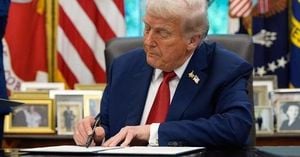The world of professional tennis finds itself at a crossroads, as a new wave of player activism takes center stage both on and off the court. On July 30, 2025, nearly all of the sport’s top men’s and women’s players—including Aryna Sabalenka, Coco Gauff, Iga Świątek, Carlos Alcaraz, and Jannik Sinner—sent a powerful second letter to the four Grand Slam tournaments, demanding sweeping reforms that could reshape the sport’s landscape for years to come.
This latest letter, which has only now surfaced, marks a significant escalation in the ongoing dialogue between players and tennis’s most influential events. The group’s demands are clear: a greater share of tournament revenues, improved player welfare benefits, and a stronger voice in the sport’s future through the creation of a Grand Slam Player Council. The letter’s signatories reflect the current elite of the ATP and WTA rankings, with Novak Djokovic, a figurehead in player advocacy, notably absent from this second push after signing the original letter in March.
So, what exactly are the players asking for? First, they want the Grand Slams to start contributing to a benefit fund aimed at bolstering player pensions, health care, and maternity benefits—areas where the ATP and WTA already make yearly contributions. Second, the players are calling for an increase in their share of Grand Slam revenues, from the current 16 percent to 22 percent by 2030. For context, major U.S. sports leagues like the NFL, MLB, and NBA see players receive close to 50 percent of revenues—a benchmark referenced by Djokovic and others in their advocacy. Finally, the group is pushing for more meaningful consultation, seeking the establishment of a Grand Slam Player Council to ensure their voices are heard on major decisions, such as the recent expansion of tournament schedules.
World No. 7 Jessica Pegula didn’t mince words when discussing the controversial move to extend Grand Slam events to 15 days, as seen at both the Australian Open and U.S. Open. “I’m not really a fan of it. I don’t know why they had to make it even longer. Well, I know why they did it—they get to sell tickets for an extra day,” Pegula said at this year’s U.S. Open. “I don’t think a lot of the players were for it, especially those who play the week before a Slam. It makes everything a little longer and a little harder.” Her sentiments echo a broader player frustration: that commercial interests are taking precedence over athlete wellbeing.
In response, Grand Slam organizers have pointed out that players were consulted about the expanded schedules and that the revenue from the additional Sunday ticket sales at the Australian Open, for instance, goes directly to the players. Still, the sense among many athletes is that their concerns are not being fully addressed.
To strengthen their case, the players have enlisted former WTA chief executive Larry Scott as a consultant. Scott, who also led the Pac-12 conference in U.S. college sports, has been instrumental in organizing meetings and strategy sessions. In 2025 alone, player representatives met with Grand Slam officials at both the French Open and Wimbledon, with Scott present at each round of talks. While discussions were described as productive, the players felt that the slams’ responses were largely noncommittal, focusing more on long-term visions for the sport than the immediate reforms the athletes are seeking.
The backdrop to these negotiations is a growing legal battle. The Professional Tennis Player Association (PTPA), co-founded by Djokovic, filed an antitrust lawsuit in March 2025, naming the four Grand Slams as co-conspirators in a supposed cartel alongside the ATP, WTA, ITF, and International Tennis Integrity Agency (ITIA). Although Djokovic himself was not listed as a plaintiff—citing discomfort with some of the language—he acknowledged, “There are things that I agree with in the lawsuit, and then there are also things that I don’t agree with.” The lawsuit has since evolved, with the ITF and ITIA removed from the complaint and the Grand Slams added as defendants as of September 2025. The ATP and WTA have filed to dismiss the suit entirely, while the PTPA insists that legal action is a necessary step to “guarantee accountability from all parties” and “accelerate long-overdue reform across the entire tennis ecosystem.”
The Grand Slams, for their part, have proposed their own vision for the sport’s future. Their “Premium Tour” concept would streamline the calendar to around 30 elite events annually, aiming to attract more fans and sponsors by creating a more unified and marketable product. This proposal, however, has yet to move beyond the discussion phase, and players remain wary that a more condensed schedule could exacerbate issues like burnout and insufficient recovery time.
Financially, the Grand Slams have pointed to significant increases in player compensation. The United States Tennis Association (USTA) responded to the July 30 letter with a detailed reply on August 18, highlighting a 21 percent jump in the 2025 U.S. Open prize money to $90 million. According to USTA interim co-CEO Brian Vahaly and outgoing tournament director Stacey Allaster, “the USTA must balance our obligations to professional players with our primary responsibility to fund the growth of tennis.” They emphasized that the 2025 purse, which saw double-digit increases for every round across singles, doubles, and wheelchair events, was made possible by the extra day added to the main draw. “We have always been willing to increase compensation for players—as evidenced by the 57 percent growth of the US Open purse over the past five years—particularly when additional collaboration on the part of the players helps to create additional revenue,” they wrote.
Wimbledon’s All England Club echoed similar sentiments, noting a doubling of its prize-money fund over the past decade. First-round payouts have jumped 128 percent, while qualifying rounds have seen a staggering 309 percent increase. A spokesperson stated, “Our position continues to be that we are always open to having constructive discussions to achieve the best possible outcome for the future success of our sport and for the benefit of our players and fans.” The club also highlighted its financial commitment to tennis’s growth beyond the iconic grass courts of SW19.
Yet, despite these increases, many players feel that tennis still lags behind other global sports when it comes to sharing the financial pie. The current impasse reflects the complexity of tennis governance, with seven different bodies—each with their own interests—making any significant change a herculean task.
As the tennis calendar marches on, the next major flashpoint is expected later this year, when the Australian Open announces its prize money for the 2026 edition. The 2025 pool was up nearly 12 percent from the previous year, but all eyes will be on whether the first Grand Slam of 2026 signals a new era of player empowerment or more of the status quo. For now, the game’s biggest stars remain united in their call for a fairer, more transparent, and more sustainable future for professional tennis. The off-court battles may be just as riveting as the action on the court.




